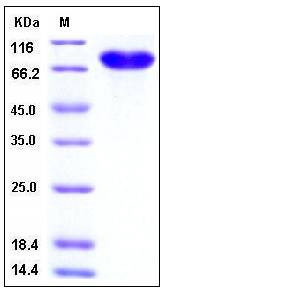Human CD14 Protein (Fc Tag)
CD14 antigen,monocyte differentiation antigen CD14
- 100ug (NPP3665) Please inquiry
| Catalog Number | P10073-H01H |
|---|---|
| Organism Species | Human |
| Host | Human Cells |
| Synonyms | CD14 antigen,monocyte differentiation antigen CD14 |
| Molecular Weight | The recombinant human Fc/CD14 chimera is a disulfide-linked homodimeric protein. The reduced monomer consists of 570 amino acids and has a calculated molecular mass of 62.4 kDa. In SDS-PAGE under reducing conditions, the apparent molecular mass of rhFc/CD14 monomer is approximately 75-85 kDa due to the glycosylation. |
| predicted N | Glu 20 |
| SDS-PAGE |  |
| Purity | > 97 % as determined by SDS-PAGE and SEC-HPLC Analysis. |
| Protein Construction | A DNA sequence encoding the extracellular domain (Thr 20-Cys 352) of the mature form of human CD14 (NP_000582.1) was fused to the Fc region of human IgG1 at the N-terminus. |
| Bio-activity | |
| Research Area | Immunology |Inflammation / Inflammatory Mediator |Cells Involved in Inflammation |Myeloid-derived Suppressor Cells (MDSC) |
| Formulation | Lyophilized from sterile PBS, pH 7.4 1. Normally 5 % - 8 % trehalose, mannitol and 0.01% Tween80 are added as protectants before lyophilization. Specific concentrations are included in the hardcopy of COA. |
| Background | The cluster of differentiation (CD) system is commonly used as cell markers in immunophynotyping. Different kinds of cells in the immune system can be identified through the surface CD molecules which associating with the immune function of the cell. There are more than 320 CD unique clusters and subclusters have been identified. Some of the CD molecules serve as receptors or ligands important to the cell through initiating a signal cascade which then alter the behavior of the cell. Some CD proteins do not take part in cell signal process but have other functions such as cell adhesion. Cluster of differentiation 14 (CD14) is a member of the CD system. It takes its name from its inclusion in the CD molecule surface marker proteins. CD14 exists in two forms: a form anchored into the membrane or a soluble form. CD14 was found expressed in macrophages, neutrophil granulocyte and dendritic cells. The major function is serve as a co-receptor (along with TLR4 and MD-2) for the bacterial lipopolysaccharide (LPS) and other pathogen-associated molecular patterns. |
| Reference |
